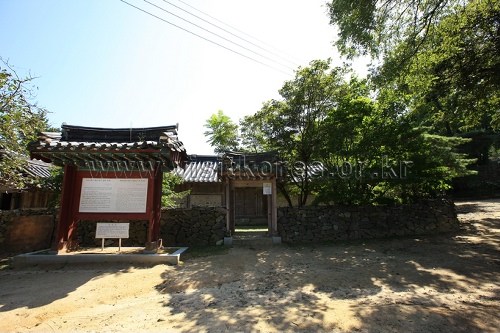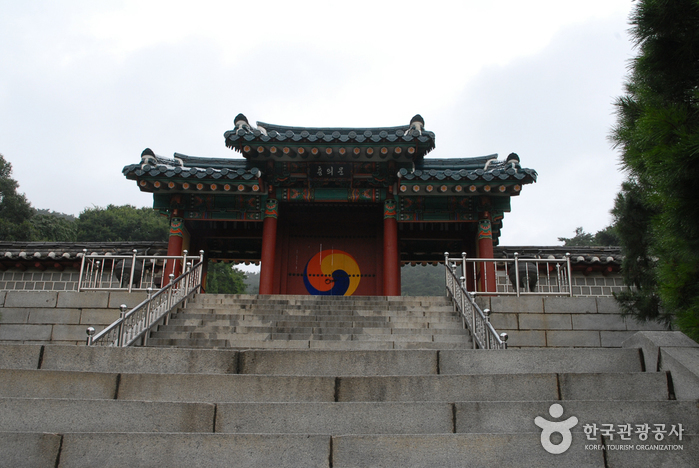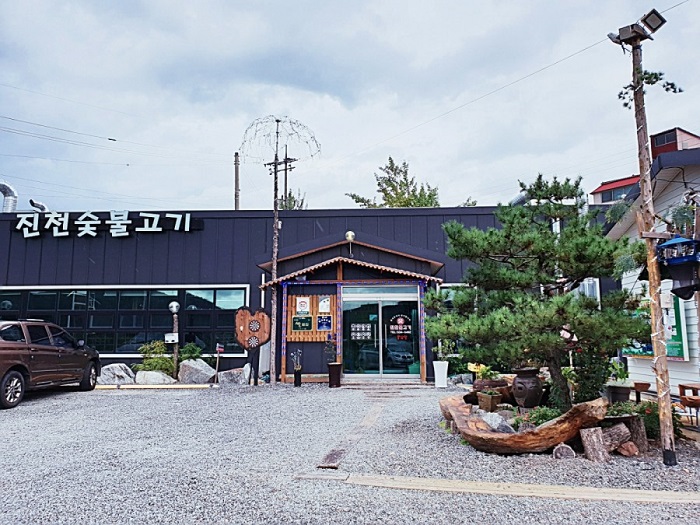Asan Mediterranean Village (지중해마을)
14.3 Km 0 2024-02-22
55-7, Tangjeongmyeon-ro 8beon-gil, Tangjeong-myeon, Asan-si, Chungcheongnam-do
Asan Mediterranean Village, also called Blue Crystal Village, is made up of buildings reminiscent of those found in a Mediterranean village. It is particularly interesting because it is housed in the heart of a modern city. The village is divided into two sections, one taking after the Provence in southern France and the other resembling Santorini in Greece. Famous sights include the photo areas of angel’s wings and a lighthouse-shaped red postbox, along with cafés and stores.
Sure Stay Plus [Korea Quality]슈어스테이플러스호텔[한국관광 품질인증]
15.0 Km 0 2023-05-23
32, Onsaem-ro, Asan-si, Chungcheongnam-do
+82-507-1426-3052
Sure Stay Plus is an American chain business hotel in the center of the Tangjeong Display Industrial Complex in Asan, Chungcheongnam-do, and is the first Sure Stay Plus hotel to open in Korea. Accomodation rates are reasonable, and all rooms have air purifiers and bathtubs. Nearby tourist attractions include the Independence Hall of Korea in Cheonan, the Korean independence heroine Yu Gwan-soon’s Memorial Hall, Oeam Folk Village, and Hyeonchungsa Temple. Public transport links are good, with KTX Cheonan-Asan Station 15 minutes away.
Sejong Cheongansa Temple (청안사(세종))
15.9 Km 6651 2021-07-21
128-23, Ganeusil-gil, Jeonui-myeon, Sejong-si
+82-44-867-3407
Sitting at the foot of a mountain near Ganeusil Village, Cheongansa Temple belongs to the Jogye Order of Korean Buddhism. It had been believed to have been built in 1900, but the roof tile and white porcelain pieces from the mid-Joseon dynasty period found near the temple suggested that it might have been built even earlier. Cheongsansa had also been thought to be a branch of Biamsa Temple, which is presumably built in the 7th century during the late Baekje kingdom period.
CU - Nam Seoul University Student Union Hall Branch [Tax Refund Shop] (cu남서울대학생회관점)
16.0 Km 0 2024-06-26
B1F, 91, Daehak-ro, Seonghwan-eup, Seobuk-gu, Cheonan-si, Chungcheongnam-do
-
Asan Maengssi Haengdan House - Maeng Sa-seong House (아산 맹씨행단(맹사성 고택)
16.4 Km 10452 2020-05-07
23-4, Haengdan-gil, Asan-si, Chungcheongnam-do
+82-41-536-8773
Maeng Sa-seong is a major figure in Cheonbaek-ri and was a prime minister during the early years of the Joseon dynasty. His house is the oldest private residence in Korea, and was originally General Choi Yeong’s home, before he turned it over to his grand son-in-law, Maeng Sa-seong. The simple residence houses two 600-year-old gingko trees in the yard. Therefore it has been named ‘Haengdan’, meaning that Confucius taught on top of the gingko tree symbolizing a place of learning. For that reason it is inferred that Maeng Sa-seong intentionally planted gingko trees in the yard and taught junior scholars. The two gingko trees provide a cool shade and give out five sacks of gingko nuts each year.
Geumisanseong Fortress (금이성)
16.6 Km 12330 2020-03-17
Songseong-ri, Sejong-si
+82-44-300-3444
Geumiseong is a mountain fortress built on the summit of Geumseongsan Mountain, which rises 430 meters above sea level. It overlooks Jeonui and Cheonan to the north and Geumgang River to the south. The architecture style of Geumiseong Fortress is a combination of the
styles of the Baekje dynasty and the early Unified Silla. Based on the relics found inside the fortress, it is thought to have been built in the Goryeo period. The robustness of the fortress takes advantage of the rugged topography, so much so that it had been known as ironclad bastion among common people.
The eastern side of the fortress has considerably collapsed, but the southern part is in a relatively good condition. The western and northern walls are also in bad conditions.
Some earthenware pieces were found where there once stood a watchtower. Also, some pieces of roof tiles were found where there was a fortress building in the central part of the fortress on mountain summit. The earthenware pieces are hard porcelain and soft glass wares like bowls and pots. The tile pieces mostly feature fishbone patterns in dark gray color.
Hyeonchungsa Shrine (현충사)
17.0 Km 27221 2020-04-03
126, Hyeonchungsa-gil, Asan-si, Chungcheongnam-do
+82-41-539-4600
Hyeonchungsa Shrine, located in Asan-si, is the shrine of General Lee Sun-Shin (1545-1598). It was built in 1706, and named Hyeonchungsa Shrine the following year. In 1932 during the Japanese occupation, a treasure preservation committee was formed to protect the shrine. Afterward, the shrine was rebuilt by the government, its area greatly enlarged, and was further developed into a sacred place.
The shrine contains Sipkyeongdo, a pictorial biography of general Lee Sun-Shin’s portrait and his life story. Nanjung Diary, designated National Treasure No. 76, his Long Sword, Treasure No. 326, and other treasures are displayed within the shrine as well, together with the old house he lived in, the arrow shooting range, and Geobuksun (turtle ship). When you enter the of Hyeonchungsa Shrine, Chungmu gate, you will see another gate called Hongsal Gate. Go past Hongsal Gate and you can see Lee Sun-Shin’s portrait, which was made with Korean Cheonggiwa tiles and iron-reinforced concrete. Inside the Gotaek Building is the Chungmujeong House, where Lee Sun-Shin spent his life until he was a young man. The newly added pond, Yeonji Pond, in Hyeonchungsa Shrine is also worth exploring.
Gayeongdang, Cheongju [Korea Quality] / 가영당 [한국관광 품질인증/Korea Quality]
17.1 Km 793 2021-10-07
71-54, Miraeji-ro, Cheongwon-gu, Cheongju-si, Chungcheongbuk-do
This hanok (traditional Korean house) is located in Ochang Hanok Village within Ochang-eup’s Miraeji Theme Park. Ochang Hanok Village is a collection of about 20 modernized hanok buildings that boast excellent views of the mountain and the Ochang Reservoir nearby. Gayeongdang is owned by Kim Byeong-hee, a master in flower tea who has studied Korea’s traditional flower tea for nearly 30 years. Visitors interested in Kim’s work have an opportunity to discuss the art of flower tea over tea and sweets with the master through Gayeongdang’s tea ceremony program.
Gayeongdang is a faithful recreation of the C-shaped hanok complex, centered around a grass lawn. It is constructed entirely out of Korean pine trees, which fills the indoor spaces with a rich scent of pine. The main and annex buildings are all Korean rooms with ondol (under-the-floor heating system). The former allows guests access to the room, the living room, and the tea ceremony room, while the latter allows opportunities for grilling in the lawn. The space is also available for small events like seminars, small concerts, and marriage ceremonies.
Uniqlo - Asan Punggi Branch [Tax Refund Shop] (유니클로 아산풍기)
17.5 Km 0 2024-04-18
1692, Oncheon-daero, Asan-si, Chungcheongnam-do
-
Jincheon Sutbul Gogi (진천숯불고기)
17.6 Km 26 2021-03-23
3, Saseok 1-gil, Jincheon-gun, Chungcheongbuk-do
+82-43-534-5492
It is a good place to hold various gatherings and has been selected as a place with excellent hygiene. This restaurant's signature menu is charcoal-grilled meat. This Korean dishes restaurant is located in Jincheon-gun, Chungcheongbuk-do.

![Sure Stay Plus [Korea Quality]슈어스테이플러스호텔[한국관광 품질인증]](http://tong.visitkorea.or.kr/cms/resource/10/2949310_image2_1.jpeg)


![Gayeongdang, Cheongju [Korea Quality] / 가영당 [한국관광 품질인증/Korea Quality]](http://tong.visitkorea.or.kr/cms/resource/83/2706983_image2_1.jpg)
![Uniqlo - Asan Punggi Branch [Tax Refund Shop] (유니클로 아산풍기)](http://tong.visitkorea.or.kr/cms/resource/08/2883308_image2_1.jpg)

 English
English
 한국어
한국어 日本語
日本語 中文(简体)
中文(简体) Deutsch
Deutsch Français
Français Español
Español Русский
Русский